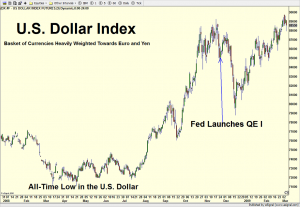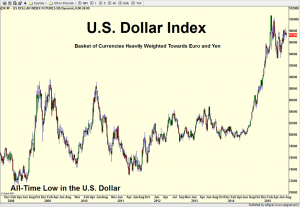China Devalues – A Look at Currencies
After a good close last Friday and strong stock market showing on Monday, the bulls hard a tough day on Tuesday as China surprised the markets by devaluing their currency, the renminbi or RMB, overnight in an effort to spur on exports. Japan has been trying to do this for several years by massive amounts of money printing. For most of the world, the free market sets the various exchange rates, but a few countries set their own exchange rates, which can be viewed, rightly so, as manipulation.
The average person traveling to Europe or Japan typically views those areas as costly and probably doesn’t realize that exchange rates fluctuate 24/7. It seems like people always complain how expensive it is to travel to Europe and Japan, but there are varying degrees of expensiveness!
When I moved to London in January 1987, I remember it costing $1.38 for one British Pound, and that was expensive at the time, although it was $1.55 when I left six months later. In hindsight, the mid $1.30s has been the low for that currency for decades. On the flip side, in late 2007, the Pound was as high as $2.10. Today, it sits at $1.55, the same price as in June 1987.
Free market currencies typically oscillate over time; the longer your timeframe, the more you can see it. They are relative value vehicles. All currencies cannot be rising or falling together as they are paired against one another. I would also include gold as a currency today.
For the most part, economic activity, inflation and perceived future interest rates determine the value of one currency against another. Notice I did not include the money supply in that equation. Contrary to popular belief, more currency printed does not always lead to a devaluation of the currency by the free market. Sometimes it does, like Japan, while other times it doesn’t, like the U.S.
Disagree?
Look no further back than our own Fed’s money printing binges, QE I, QE II and QE Unlimited.
In the example above, the dollar hit its ALL-TIME LOW in March and April 2008. That was before QE was launched or even announced. By the time QE began in November 2008, the dollar had already rallied more than 20%, a hugely dramatic move for a currency.
By the time the Fed was done printing $4 TRILLION, contrary to popular belief, our currency did not disintegrate into worthless ashes. Rather, as you can see below, the dollar was still in rally mode and about to go parabolic over the past year.
It’s certainly no secret to readers that I have been long-term bullish the greenback since early 2008. I have mentioned in every Fearless Forecast for at least six years. I do not believe the run is over. Action in the dollar has been constructive and the next leg higher should carry it well above 101 on the index and possibly to 110. Eventually, that will cause massive capital inflows into the U.S. as we saw in the mid 1980s, which should be bullish for large cap stocks. The long-term problem is that we could see some serious global imbalances with a market crisis to accompany that, but that would be a few years down the road.
If you would like to be notified by email when a new post is made here, please sign up, HERE.



